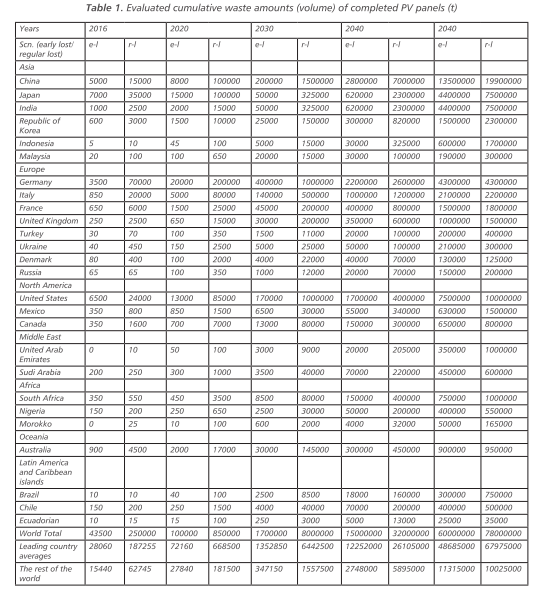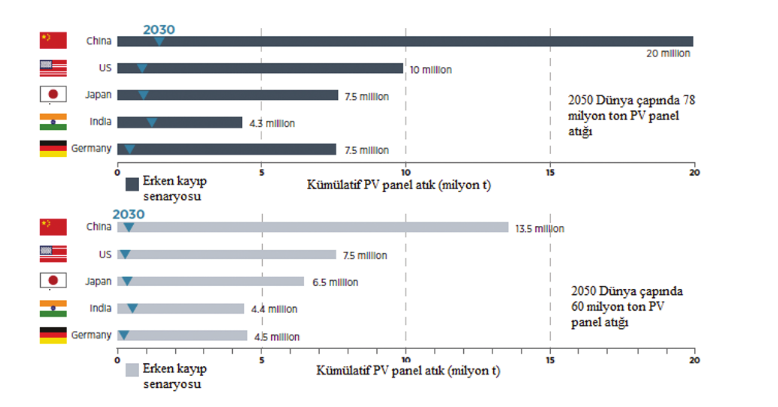In this article, PV panel waste evaluates by privileged countries is shown from 2016 to 2050 in detail. Countries are preferred to depend on their provincial leader once it becomes to PV distribution and required advancement.
The prolongations are planned to use the like Weibull function inputs as the Worldwide predictions of the past part. Programmed waste amounts of PV panels in party countries are depend current and near-future yearly set-ups and based upon parameters available for every country. Historical cumulative setup PV amount is explained in each country by a simple interpolation, as well as future projections for 2030
Introduction
Country-modeled responses of evaluated cumulative waste amounts (volume) of PV panels that have completed their life are given in Table 1 (t).


2030’s PV Panel Waste Estimations
The demonstrated reactions show that the most elevated PV board squander streams expected by 2030 are in Asia, amassing up to 3.5 million tons, contingent upon the situation. Territorial Asian heroes in sustainable power dissemination will along these lines experience the most noteworthy waste stream. For instance, China will have an introduced PV limit of 420 GW in 2030 and will actually want to collect between 200,000 tons and 1.5 million tons of waste around the same time. This is trailed by Japan and India, with assessments of between 200,000 tons and 1 million tons and 50,000-325,000 tons, separately, in combined PVsquander by 2030.
Europe is required to offer the second-biggest PV squander market by 2030, with an expected misuse of as much as 3 million tons. Germany, which is projected to have a 75 GW of PV limit, is projected to look somewhere in the range of 400,000 and 1 million tons of PV board squander by 2030. Other significant future PV squander markets are anticipated to incorporate Italy and France.
With an aggregate 240 GW expected in introduced PV by 2030, the US will be the pioneer as far as the absolute introduced PV limit in North America. It is projected to deliver somewhere in the range of 170,000 and 1 million tons of waste by at that point. Nations like Canada (as much as 80,000 tons) and Mexico (as much as 30,000 tons) will likewise encounter expanded PV squander streams by 2030.
By 2030, Africa and Latin America are likewise gauged to see rising PV-squander volumes. South Africa (8,50080,000 tons by 2030) and Brazil (2,500-8,500 tons by 2030) will be territorial pioneers in this regard. Other key PV-squander markets by 2030 will incorporate the Republic of Korea with 25,000-150,000 tons of combined waste and Australia with 30,000-145,000 t.
Waste Volume Expansion in 2030-2050
Given the overall expansion in PV dissemination since 2010 and the normal lifetime and disappointment rates for boards, it is sure that squander volumes will increment quicker after 2030. In 2030, the best three PV board squander nations are relied upon to incorporate China, Germany, and Japan. By 2050, the image is evolving marginally. By at that point, China is as yet assessed to have gathered the biggest measure of waste (13.5-20 million tons).
Notwithstanding, Germany is surpassed by the US (7.5-10 million tons), trailed by Japan (6.5-7.5 million tons) and India (4.4-7.5 million tons). Customary misfortune and early misfortune squander gauges by the best five nations in 2030 and 2050 are appeared in Figure 1. The examination introduced in this part creates quantitative evaluations for PV board squander streams by country and district by 2050 and on a worldwide scale. Simultaneously in scale, PV boards, and consequently their waste, vary in arrangement and administrative order, which will be talked about in the following area.
[caption id="attachment_126430" align="aligncenter" width="778"]
 Figure 1.
Figure 1. Assessed aggregate waste volumes of end-of-life PV boards by the main five nations in 2050 with early misfortune situation (top) and customary misfortune situation (base)[/caption]
[caption id="attachment_126432" align="alignnone" width="153"]
 Cemil Koyunoğlu
Cemil Koyunoğlu Faculty of Engineering Department of Energy Systems Engineering Yalova University[/caption]



 Figure 1. Assessed aggregate waste volumes of end-of-life PV boards by the main five nations in 2050 with early misfortune situation (top) and customary misfortune situation (base)[/caption]
[caption id="attachment_126432" align="alignnone" width="153"]
Figure 1. Assessed aggregate waste volumes of end-of-life PV boards by the main five nations in 2050 with early misfortune situation (top) and customary misfortune situation (base)[/caption]
[caption id="attachment_126432" align="alignnone" width="153"] Cemil Koyunoğlu Faculty of Engineering Department of Energy Systems Engineering Yalova University[/caption]
Cemil Koyunoğlu Faculty of Engineering Department of Energy Systems Engineering Yalova University[/caption]